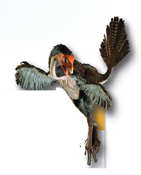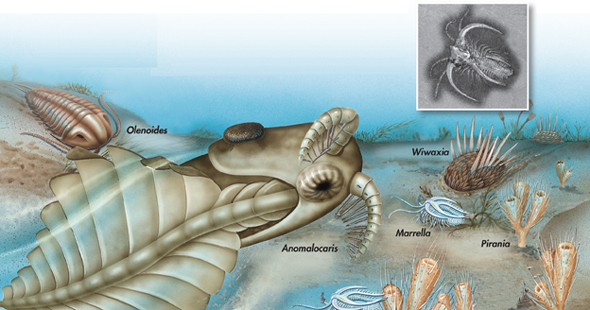The Ediacaran Fauna Some of the most exciting and important discoveries about animal life before the Cambrian Period come from fossils in the Ediacara Hills of Australia. These strange fossils, which date from roughly 565 to about 544 million years ago, have intrigued paleontologists for years. The body plans they show are different from those of anything alive today. They show little evidence of cell, tissue, or organ specialization, and no organization into a front and back end. Some may have had photosynthetic algae living within their bodies. Some were segmented and had bilateral symmetry. Some seem to be related to invertebrates such as jellyfishes and worms. Many of the organisms were flat and lived on the bottom of shallow seas.
MYSTERY CLUE

How old would rocks need to be in order to contain fossils of the earliest known animals?
The Cambrian Explosion Fossils from the Cambrian Period, which began about 542 million years ago, paint a fascinating picture of invertebrate life. Two major Cambrian fossil sites are in Chengjiang, China, and in the Burgess Shale of Canada. Cambrian fossils show that over a period of 10–15 million years, animals evolved complex body plans, including specialized cells, tissues, and organs. Many had body symmetry; segmentation; a front and back end; and appendages, structures such as legs or antennae protruding from the body. Some Cambrian animals had also evolved shells, skeletons, and other hard body parts. Hard body parts tend to persist longer after an organism dies, so they are more likely to become fossilized.
A number of Cambrian fossils have been identified as ancient members of modern invertebrate phyla, such as the arthropod Marrella in Figure 26–2. However, some early Cambrian fossils represent extinct groups so peculiar that no one knows what to make of them! Other Cambrian animals appear to be early chordates. By the end of the Cambrian Period, all the basic body plans of modern phyla had been established. Later evolutionary changes, which produced the more familiar body structures of modern animals, involved significant variations on these basic body plans.
Modern Invertebrate Diversity Today, invertebrates are the most abundant animals on Earth. They live in nearly every ecosystem, participate in nearly every food web, and vastly outnumber so-called “higher animals,” such as reptiles and mammals.

FIGURE 26–2 Cambrian Animals This Cambrian Period fossil of Marrella splendens was found in the Burgess Shale in Canada. The illustration shows what Marrella and other Burgess Shale animals may have looked like. Infer Why do scientists have more detailed data on Cambrian animals than they do on pre-Cambrian animals?
Table of Contents
- Formulas and Equations
- Applying Formulas and Equations
- Mean, Median, and Mode
- Estimation
- Using Measurements in Calculations
- Effects of Measurement Errors
- Accuracy
- Precision
- Comparing Accuracy and Precision
- Significant Figures
- Calculating With Significant Figures
- Scientific Notation
- Calculating With Scientific Notation
- Dimensional Analysis
- Applying Dimensional Analysis




